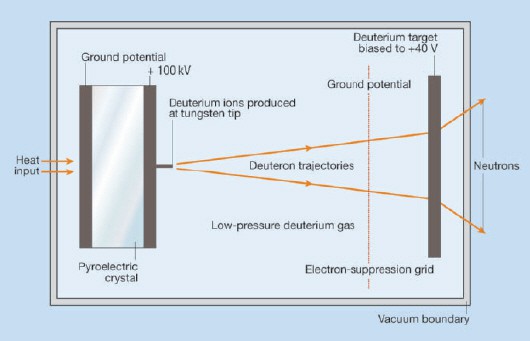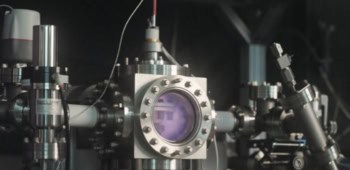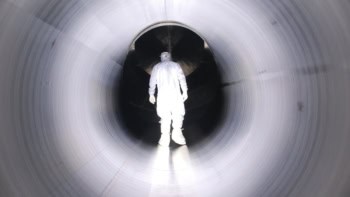Physicists in the US have generated nuclear fusion in a simple, table-top device operating at room temperature. The device, built by Brian Naranjo, Jim Gimzewski and Seth Putterman at the University of California at Los Angeles (UCLA), causes two deuterium nuclei to collide with each other and generate alpha particles, neutrons and energy (Nature 434 1115). The device could have applications as a portable neutron generator or in the propulsion systems for miniature spacecraft, but will not be useful as an energy source because it consumes more energy than it produces.

The experimental set-up consists of a centimetre-sized cylindrical crystal of lithium tantalate (LiTaO) surrounded by deuterium gas. This material is pryoelectric, which means that positive and negative charges build up on opposite faces of the crystal when it is heated. This creates an electric field that is high enough to ionize any deuterium atoms that stray near a tiny tungsten tip attached to the positively charged surface. These deuterium ions get repelled from the surface and are accelerated by the field towards an erbium deuteride target, where the fusion reactions take place.
The device currently emits about 900 neutrons every second, and the UCLA team say that it could be used as a “simple palm-sized neutron generator” if the output can be increased to about one million neutrons per second. Using tritium rather than deuterium in the target will increase the neutron yield by a factor of 250, says Naranjo, and optimizing the geometry and increasing the beam current should provide another factor of four.
“What they have made is a cute little neutron generator,” says Michael Saltmarsh, a physicist who has retired from the Oak Ridge National Laboratory in the US. “You can imagine having one of those in your pocket but don’t get it too warm! However, the neutron intensity is still much lower than you can get from commercially available neutron generators.”
Putterman and co-workers at UCLA are also involved in efforts to generate fusion reactions in “sonoluminescence” experiments in which bubbles in a liquid are forced to expand and contract by sound waves. In 2002 Rusi Taleyarkhan of Oak Ridge and colleagues reported that they had observed “bubble fusion” in experiments with deuterated acetone. The report was greeted with skepticism by other researchers in the field, including the UCLA group, who were unable to reproduce the results. However, the Defense Advanced Research Projects Agency (DARPA) in the US has recently funded Taleyarkhan, who is now at Purdue University, and Putterman to collaborate and exchange information on bubble fusion.




